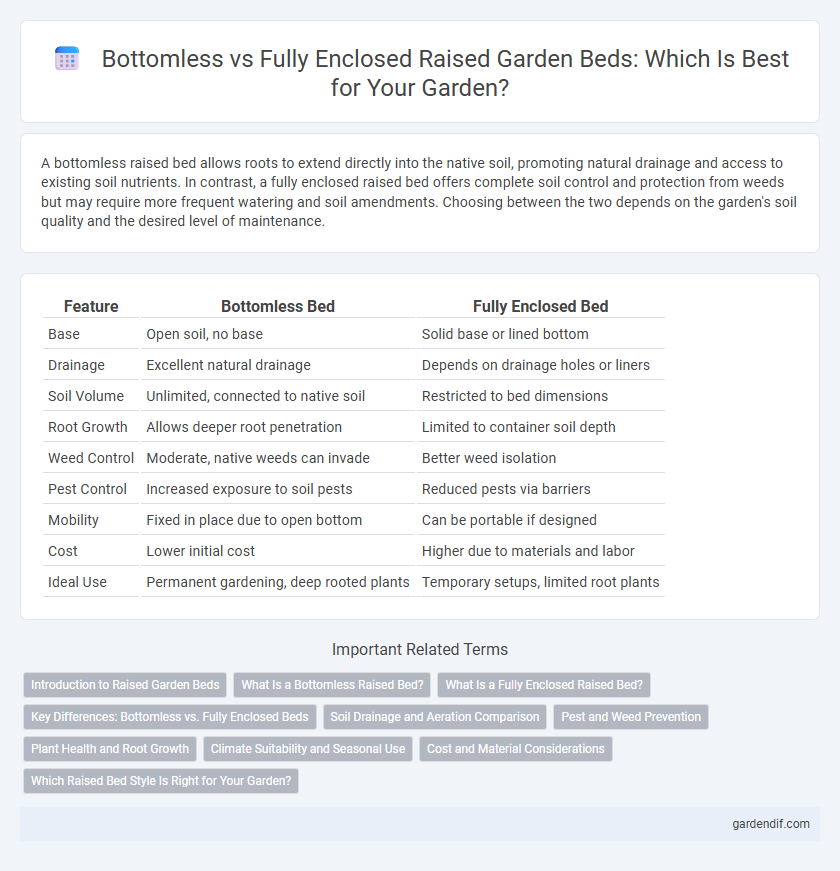
Bottomless bed vs Fully enclosed bed Illustration
A bottomless raised bed allows roots to extend directly into the native soil, promoting natural drainage and access to existing soil nutrients. In contrast, a fully enclosed raised bed offers complete soil control and protection from weeds but may require more frequent watering and soil amendments. Choosing between the two depends on the garden's soil quality and the desired level of maintenance.
Table of Comparison
| Feature | Bottomless Bed | Fully Enclosed Bed |
|---|---|---|
| Base | Open soil, no base | Solid base or lined bottom |
| Drainage | Excellent natural drainage | Depends on drainage holes or liners |
| Soil Volume | Unlimited, connected to native soil | Restricted to bed dimensions |
| Root Growth | Allows deeper root penetration | Limited to container soil depth |
| Weed Control | Moderate, native weeds can invade | Better weed isolation |
| Pest Control | Increased exposure to soil pests | Reduced pests via barriers |
| Mobility | Fixed in place due to open bottom | Can be portable if designed |
| Cost | Lower initial cost | Higher due to materials and labor |
| Ideal Use | Permanent gardening, deep rooted plants | Temporary setups, limited root plants |
Introduction to Raised Garden Beds
Bottomless raised garden beds provide excellent soil drainage and natural nutrient exchange by allowing roots to access native soil directly, making them ideal for plants requiring deep root systems. Fully enclosed raised beds, equipped with barriers such as wood or metal on all sides including the bottom, offer enhanced control over soil quality and prevent weed invasion, beneficial in areas with poor or contaminated soil. Choosing between these beds depends on soil conditions, plant types, and drainage needs to optimize garden productivity.
What Is a Bottomless Raised Bed?
A bottomless raised bed is a garden structure without a solid base, allowing plant roots to grow directly into the existing soil beneath, ensuring natural drainage and soil microbial activity. This design contrasts with a fully enclosed raised bed, which has a bottom made of wood, metal, or plastic, often filled with imported soil or compost. Bottomless raised beds are ideal for retaining local soil structure, enhancing root access to nutrients and water within the native ground, while minimizing soil displacement and costs.
What Is a Fully Enclosed Raised Bed?
A fully enclosed raised bed features solid walls on all sides and a bottom base, providing complete separation from the surrounding soil. This design helps control soil quality, prevents weed intrusion, and retains moisture more effectively compared to bottomless beds. Gardeners often choose fully enclosed beds for better root protection and easier soil management in various environments.
Key Differences: Bottomless vs. Fully Enclosed Beds
Bottomless raised beds allow roots to grow directly into the native soil, enhancing drainage and soil biodiversity, making them ideal for areas with poor drainage. Fully enclosed beds provide complete containment of soil, preventing weed invasion and soil erosion, which is beneficial for growing in areas with contaminated or compacted soil. The choice depends on soil quality, root expansion needs, and maintenance preferences.
Soil Drainage and Aeration Comparison
Bottomless raised beds offer superior soil drainage and aeration by allowing excess water to escape directly into the ground, preventing waterlogging and promoting healthy root systems. Fully enclosed raised beds can retain moisture longer, which may lead to poor drainage and reduced oxygen flow unless proper drainage holes or materials are used. Choosing bottomless designs enhances natural soil processes, improving plant health and growth through better air and water movement.
Pest and Weed Prevention
Bottomless raised beds allow natural soil organisms to thrive and promote drainage but are vulnerable to burrowing pests like moles and root weevils. Fully enclosed raised beds, constructed with barriers such as hardware cloth or metal mesh at the base, offer superior protection against subterranean pests and reduce weed growth by preventing weed seed intrusion from surrounding soil. Using mulch and landscape fabric inside fully enclosed beds further enhances weed suppression and minimizes pest habitats, creating a controlled growing environment.
Plant Health and Root Growth
Bottomless raised beds enhance plant health by allowing roots to extend naturally into native soil, promoting better oxygenation and drainage critical for robust root development. Fully enclosed beds restrict root expansion to contained soil, which can limit nutrient access and increase the risk of waterlogging or root rot if not managed carefully. Selecting a bed type should consider soil quality and drainage needs, as bottomless beds foster healthier root systems in well-draining soils, while fully enclosed beds provide more control in poor or compacted soils.
Climate Suitability and Seasonal Use
Bottomless raised beds offer superior drainage and soil temperature regulation, making them ideal for warm, temperate climates where excess moisture can be an issue. Fully enclosed beds retain heat and moisture more effectively, supporting extended growing seasons in cooler or variable climates by protecting soil from rapid temperature fluctuations. Selecting the appropriate bed design based on regional climate maximizes plant growth and resource efficiency throughout seasonal changes.
Cost and Material Considerations
Bottomless raised beds typically involve fewer materials, reducing costs by eliminating the need for a base, making them ideal for gardeners with budget constraints or existing soil conditions. Fully enclosed beds require more material, such as wood, metal, or composite panels for all sides, increasing initial investment but offering better soil control and durability. Choosing between these options depends on balancing upfront expenses against long-term benefits like soil retention and pest management.
Which Raised Bed Style Is Right for Your Garden?
Choosing between a bottomless raised bed and a fully enclosed raised bed depends on your garden's soil quality and drainage needs. Bottomless raised beds allow roots to grow deeper and encourage natural soil ecology, ideal for gardens with rich, well-draining soil. Fully enclosed raised beds, with a solid base, are perfect for areas with poor soil or unwanted pests, providing greater control over soil composition and moisture retention.
Bottomless bed vs Fully enclosed bed Infographic

 gardendif.com
gardendif.com